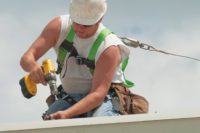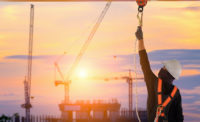Guardrails, nets & fall arrests
Set up your fall protection system early in the work process

Preventing falls from heights when performing construction work is a top priority because falls are the leading cause of fatalities in the construction industry. According to the Bureau of Labor Statistics, in 2017, there were 366 fatal falls to a lower level out of 971 construction fatalities.
To prevent these fatalities, OSHA’s construction fall protection standard at 29 CFR 1926 Subpart M has numerous options to choose from to protect your employees. You can select and use a fall protection system (or combination of systems) that addresses the hazards of a specific walking/working surface.
Unprotected sides and edges
Protect employees when they are exposed to falls from unprotected sides and edges of walking/working surfaces (horizontal and vertical surfaces) which are six feet or more above lower levels. The options from which you can choose to provide this protection are:
- Guardrail systems.
- Safety net systems.
- Personal fall arrest systems.
OSHA considers these three types of systems to be “conventional fall protection systems.” Whatever system you use, OSHA expects you to implement it early in the construction process. Maintain that system in place until all work has been completed — or until the permanent elements of the structure which will eliminate the exposure to falling hazards are in place.
Leading edge work
Like unprotected sides and edges, when constructing leading edges six feet or more above lower levels you must protect workers by one of the same three methods.
If you can demonstrate that it is infeasible or creates a greater hazard to implement these systems, you must develop and implement a fall protection plan that meets the requirements of 1926.502(k).
When you have employees on walking/working surfaces where leading edges are under construction, but who are not constructing the leading edge, they must also be protected from a fall by the same systems listed above.
If a guardrail system is chosen and a controlled access zone has already been established for leading edge work, the control line may be used instead of a guardrail along the edge that parallels the leading edge.
Note: A leading edge is considered to be an “unprotected side and edge” during periods when it is not actively and continuously under construction.
Holes
Employees may be injured or killed if they step into holes, trip over holes, fall through holes, or are hit by objects falling through holes.
Employees on walking/working surfaces must be protected from falling into or through holes (including skylight openings) six or more feet above lower levels by:
- Installing covers over the hole,
- Erecting a guardrail system around the hole, or
- The use of a personal fall arrest system.
- Tripping in or stepping into or through holes (including skylights) by covers.
- Objects falling through holes (including skylights) by covers
OSHA does not intend that a guardrail be erected around holes while employees are working at the hole or passing materials through it. If the cover is removed while work is in progress, guardrails are not required because they would interfere with the performance of work. When the work has been completed, the employer will be required to either replace the cover or erect guardrails around the hole.
Overhand bricklaying and related work
Protect workers performing overhand bricklaying and related work six feet or more above lower levels by one of the following systems:
- Guardrail systems,
- Personal fall arrest systems,
- Safety net systems, or
- Controlled access zones.
Note: Bricklaying operations performed on scaffolds are regulated by 1926 Subpart L—Scaffolds.
Roofing work on low-slope roofs
Protect employees when they are performing roofing activities on low-slop roofs with unprotected sides and edges six feet or more above lower levels. Your options are:
- Guardrail systems,
- Safety net systems,
- Personal fall arrest systems, or
A combination of:
- Warning line and guardrail systems,
- Warning line and safety net systems,
- Warning line and personal fall arrest systems, or
- Warning line safety monitoring systems (on roofs 50 feet or less in width).
As you can see, there are various options available to protect your employees from fall hazards on the construction jobsite. Select and implement the ones that work best for your situation and give your employees the safe work environment they deserve.
Looking for a reprint of this article?
From high-res PDFs to custom plaques, order your copy today!






